According to the different processing methods, the pickling and passivation treatment of stainless steel plates mainly includes dipping method, paste method, brushing method, spraying method, circulation method, electrochemical method and other methods.
Stainless steel pipelines, small elbows, etc. are most suitable for this method, and the treatment effect of this method is the best. Therefore, the treated parts can be completely immersed in the pickling passivation solution, the surface of the stainless steel pipe can be fully reacted, and the passivation film will be more uniform and dense. This method is suitable for continuous batch processing, but it is necessary to observe the reduction of the reaction concentration of the solution at any time and continuously replenish the new solution. The disadvantage of this method is that it is limited by the shape and capacity of the acid tank, and it is not suitable for large-capacity equipment and pipelines whose shape is too long and wide; if not used for a long time, the effect will be reduced due to the volatilization of the solution. equipment, etc.

The pickling passivation paste that can be used for stainless steel pipes has been widely used and has a series of products. The main components are composed of nitric acid, hydrofluoric acid, corrosion inhibitor, viscous agent, etc. Manual operation, suitable for on-site construction, suitable for welding seam treatment of stainless steel chemical containers, welding discoloration, corner dead corners, the back of escalators and large-area smear passivation.
The advantages of the paste method are that it does not require special equipment and venues, and does not require heating equipment. The on-site operation is very flexible. The pickling and passivation can be completed at one time, and the independence is relatively strong. The passivation paste is one-time use, and the reaction stops after the passivation of the surface layer is completed. The disadvantage is that the worker's operating environment is poor, the labor intensity is high, the cost is high, and the treatment effect on the inner wall of the stainless steel pipeline is slightly poor, and other methods need to be combined.
This method is suitable for pickling and passivation of a single product in a fixed site and a closed environment or equipment with a simple internal structure, such as the spray pickling process on the sheet production line, and for stainless steel chemical containers, it can be used for pickling the inner wall of the container. The advantages of this method are that the continuous operation speed is fast, the operation method is relatively simple, the corrosion effect on workers is small, and the utilization rate of the solution is high. This method has many restrictions, such as no residues, impurities, etc. in the container; if the pickling solution stays in the container for too long, it will react and cause excessive corrosion of the stainless steel. In case of power outage, water outage, work stoppage, etc., it will cause serious consequences; waste acid and waste water must be stored in a larger container; with the increase of reaction time and the increase of impurities in the solution, the effective components of the pickling solution gradually decrease, and it is necessary to regularly Check the concentration of the solution and replenish the new solution in time.